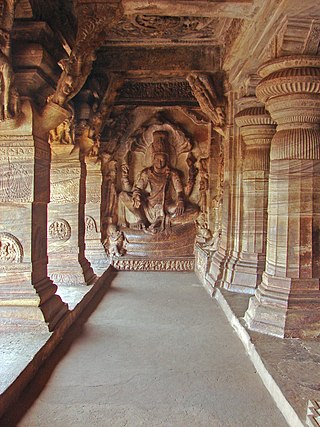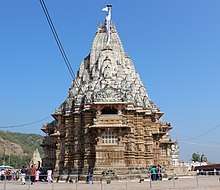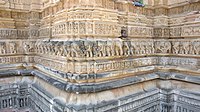
Palanpur is a city and a headquarters of Banaskantha district in the Indian state of Gujarat. Palanpur is the ancestral home to an industry of Indian diamond merchants.
Radhanpur is a town and a municipality in Patan district in the Indian state of Gujarat.

Pashupatinath Temple at Mandsaur, also referred to as the Mandsaur Shiva temple, is a Hindu temple dedicated to Lord Shiva in Mandsaur, Madhya Pradesh, India. It belongs to Pashupatinath tradition which is one of 6 major tradition within Shaivism. It is located on Shivna River, and is known for its eight-faced Shiva Linga. The temple sculpture is dated to the 5th or 6th century based on inscriptions, with some referring to the site as Dashapura. It is near the Rajasthan border in the historic region of Malwa, about 200 kilometres (120 mi) from Indore, about 340 kilometres (210 mi) west of Udaigiri Caves and about 220 kilometres (140 mi) east of Shamalaji ancient sites, both a significant source of Gupta Empire era archaeological discoveries. The site has been important to dating and the architectural studies of some distant sites such as the Elephanta Caves.

Taranga is a Jain pilgrimage center near Kheralu in Mehsana district, Gujarat, India, with two compounds of Jain temples that are important examples of the Māru-Gurjara style of architecture. The Ajitnatha temple, was constructed in 1161 by the Chaulukya king Kumarapala, under the advice of his teacher, Acharya Hemachandra. Both the main sects of Jainism are represented, with adjoining walled compounds: the Śvetāmbara compound consists of 14 temples in all, and there are also five Digambara-affiliated temples at Taranga hill.

Khedbrahma is a town and a taluka headquarter in Khedbrahma Taluka of Sabarkantha district, Gujarat, India. It is situated on the banks of Harnav river. The town is connected with mythological history and has been pilgrim site for centuries. The 11th century Brahma, Ambika and Pankhnath Mahadev temples are the oldest monuments of the town. The town has an old stepwell, the Brahma Vav. It was under Parmaras, Chaulukyas and Pariharas before it came under Idar State in 13th century.

The Badami cave temples are a complex of Budhist,Hindu and Jain cave temples located in Badami, a town in the Bagalkot district in northern part of Karnataka, India. The caves are important examples of Indian rock-cut architecture, especially Badami Chalukya architecture, and the earliest date from the 6th century. Badami is a modern name and was previously known as "Vataapi", the capital of the early Chalukya dynasty, which ruled much of Karnataka from the 6th to the 8th century. Badami is situated on the west bank of a man-made lake ringed by an earthen wall with stone steps; it is surrounded on the north and south by forts built during Early Chalukya and in later times.
Kankrej thana or Kankrej Estates was a former collection of native states in what is now part of Banaskantha district of Gujarat, India.

Bhitargaon is a town, near city of Kanpur in Kanpur Nagar district, Uttar Pradesh, India, known for its ancient Hindu temple, the largest Indian brick temple to survive from the time of the Gupta Empire. Despite being heavily restored, a number of original features remain. It is dated to the late 5th century.

Narayan Sarovar or Narayansar is a village and place of pilgrimage for Hindus on the Kori Creek. It is located in Lakhpat taluka of Kutch district in the Indian state of Gujarat. The ancient Koteshwar temple lies 4 km away, towards the north-west. The temple is classified among the 108 Abhimana Kshethram of Vaishnavate tradition.

Kera is a village in Bhuj Taluka of Kutch district of Gujarat, India.this historical town was ruled by the jadeja's before independence in 1947. This historical town has several places of interest; the most important part of the town's history the Darbar gadh, the ruins of an old fort and Shiva temple, and the shrine of a Muslim saint Ghulam Ali.
Kotai is a village in Bhuj Taluka of Kutch district of Gujarat, India. It lies on the shore of Greater Rann of Kutch. village near the sun temple
Bhavnath Temple is an ancient temple dedicated to Shiva in Mau village of Bhiloda Taluka of Aravalli district, Gujarat, India.
Morvada is a village in Vav Taluka of Banaskantha district in Gujarat, India.
Dhima is a village in Vav Taluka of Banaskantha district in Gujarat, India.
Kasara is a village in Kankrej Taluka of Banaskantha district in Gujarat, India.

The Shiva temple, Kera, also known as Lakheshwara temple of Kerakot, is located in Kera village near Bhuj of Kutch district in Gujarat, India. The temple was built during the reign of the Chaulukya dynasty (Solankis) in the later part of the 10th Century and is dedicated to Shiva. The temple has been subjected to severe earthquake damage during the earthquake of 1819 and the Bhuj earthquake of 2001. But the temple's spire, inner sanctum and the sculptures are still in an attractive condition.

The Khed-Roda Group of Monuments include eighth-ninth century dated seven Hindu temples built during Gurjara-Pratihara or Rashtrakuta period. It also include a reservoir (Kund) and a stepwell. They are located between Raisingpura (Roda) and Khed Chandarani villages, 18 km from Himmatnagar in Sabarkantha district of Gujarat, India. It is located on the bank of the seasonal stream which merges Hathmati river downstream.

Devnimori, or Devni Mori, is a Buddhist archaeological site in northern Gujarat, about 2 kilometres (1.2 mi) from the city of Shamlaji, in the Aravalli District of northern Gujarat, India. The site is variously dated to the 3rd century or 4th century CE, or circa 400 CE. Its location was associated with trade routes and caravans in the area of Gujarat. Site excavations have yielded Buddhist artifacts dated prior to 8th-century in the lowest layer, mixed Buddhist and Hindu artwork from the Gurjara-Pratihara period in the middle, topped by Muslim glazed ware attributed to the 14th century. The site was excavated between 1960 and 1963. The site became flooded by the Meswo reservoir, a project started in 1959 and completed between 1971–1972 over the nearby Meshwo River.

The Parel Relief or Parel Shiva is an important monolithic relief of the Hindu god Shiva in seven forms that is dated by the Archaeological Survey of India (ASI) to the late Gupta period, in the 5th or 6th century AD.

Brahma Temple or Brahmaji Mandir is a Hindu temple dedicated to Brahma in Khedbrahma, Gujarat, India. It is built in third quarter of the 11th century.




















